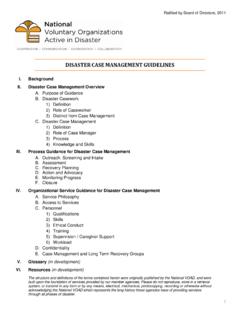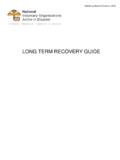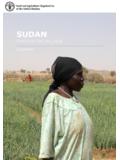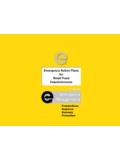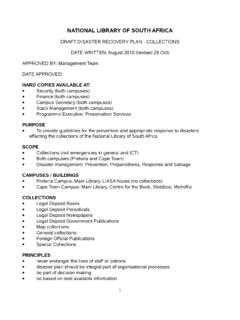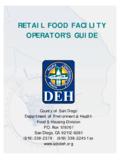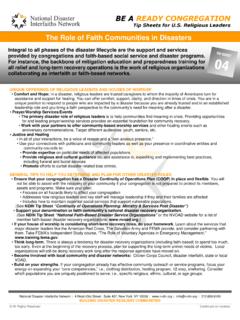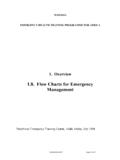Transcription of National VOAD Disaster Spiritual Care Guidelines
1 National voad Disaster Spiritual care Guidelines Ratified 2014 1 National voad Disaster Spiritual care Guidelines National voad Disaster Spiritual care Guidelines Ratified 2014 2 Introduction to the National voad Disaster Spiritual care Guidelines You are about to read the Guidelines developed by the National voad Emotional and Spiritual care Committee for providing appropriate and respectful Disaster Spiritual care . The ESC committee reaffirms the conviction that, Spirituality is an essential part of humanity. Disaster significantly disrupts people s Spiritual lives. Nurturing people s Spiritual needs contributes to holistic healing.
2 Every person can benefit from Spiritual care in time of Disaster . ( National voad DSC Points of Consensus #1) The overreaching question that motivated the development of these Guidelines was, How can National voad member organizations partner with local Spiritual care providers and communities of faith in providing appropriate and respectful Disaster Spiritual care ? Throughout the process we were guided by the spirit of the National voad 4Cs Cooperation Communication Coordination Collaboration In the context of these Guidelines you are invited to consider an additional C , Compassion. Compassion is an important component in all areas of Disaster response and an essential component in the provision of Disaster Spiritual care .
3 A compassionate presence is an invaluable gift that a Disaster Spiritual care provider offers a survivor. The writing team was mindful of emerging trends within the provision of Disaster Spiritual care . 1. Survivors access to appropriate and respectful Spiritual care is essential throughout the Disaster response. This is reflected in the following National voad documents. The National voad Disaster Spiritual care Points of Consensus #1. The National voad Case Management Guidelines , page 6. These Guidelines recognize that the assessment of a client s Spiritual needs and faith-related resources is a crucial aspect of a client s holistic recovery plan.
4 The National voad Long Term Recovery Guide, Chapter 9. The National voad Mass care Sheltering Guidance Aid, part 3, and in the Shelter Staffing Matrix. (Note: all these documents are available at ) 2. In an effort to bring greater responsibility and accountability to Disaster response, the Department of Homeland Security through the National Incident Management System published, in August of 2011, a document entitled, Guideline for the Credentialing of Personnel. While credentialing is not required for Non-governmental Agencies, Section 5 establishes the recommended model credentialing standard for NGOs which collectively refers to voluntary, charitable, faith-based, and not-for-profit organizations.
5 NGOs are not required to comply with these credentialing standards, however, their implementation and compliance with these recommendations ensures consistency with all credentialing activities by other response organizations and responder personnel. (NIMS Guideline for the Credentialing of Personnel page 23.) The complete document can be found at The intent of the credentialing is to allow for greater interoperability, commonality, and consistency. All of which are essential for a faithful Disaster response. A more detailed discussion of this topic can be found in Section 4. 3. Many National voad member organizations have a long and positive tradition of providing appropriate and respectful Disaster Spiritual care .
6 In addition, many member organizations have developed trainings to prepare their deployed personnel to provide Disaster Spiritual care . Recognizing the value of these trainings the Guidelines do not endorse one training over another. Rather the Guidelines speak of core National voad Disaster Spiritual care Guidelines Ratified 2014 3 competencies that are essential. One goal of these Guidelines is for member organizations to ensure that their required training leads to the competencies suggested. See Section 4 for more details. 4. In recent years municipalities, counties and states have intentionally integrated Disaster Spiritual care into their Disaster response and recovery plans.
7 These Guidelines reflect many of the practices that already exist and bring greater interoperability, commonality and consistency with the service delivery of Disaster Spiritual care . State VOADs will be crucial in introducing these Guidelines across the country. It is imperative for each state and regional voad to have an active and engaged Emotional and Spiritual care Committee. It will be through the ESCC that the Guidelines will become operationalize within each municipality, county and state. 5. Finally the Guidelines are the realization of Disaster Spiritual care Points of Consensus #10, National voad members affirm the importance of cooperative standards of care and agreed ethics.
8 Adherence to common standards and principles in Spiritual care ensures that this service is delivered and received appropriately. Minimally, any Guidelines developed for Spiritual care in times of Disaster should clearly articulate the above consensus What follows is by no means the final word on Guidelines . As new insights arise there will be the opportunity for all involved in this significant endeavor to learn and grow. The Guidelines come as a result of much prayer, conversation, reflection and inspiration. Respectfully Submitted, National voad Emotional and Spiritual care Committee National voad Disaster Spiritual care Guidelines Ratified 2014 4 National voad Emotional and Spiritual care Committee Disaster Spiritual care Guidelines 1.
9 SECTION ONE: Background, Purpose and Scope 2. SECTION TWO: Striving for Excellence Disaster Spiritual care 3. SECTION THREE: Striving for Excellence as an Organization 4. SECTION FOUR: Disaster Spiritual care Providers in Shared Settings a. Includes specific discussion of credentialing, competencies, qualifications, identification, typing and accountability 5. SECTION FIVE: Intentional Integration of Disaster Spiritual care Within Recovery and Response 6. APPENDICIES: a. APPENDIX A: Suggestions for Local Communities of Faith b. APPENDIX B: Job Aid for the Faith Community Representative c. APPENDIX C: Fact Sheet for Emergency Management - Disaster Spiritual care d.
10 APPENDIX D: Glossary and Acronyms e. APPENDIX E: Community Spiritual Assessment f. APPENDIX F: Resources National voad Disaster Spiritual care Guidelines Ratified 2014 5 SECTION ONE: Background, Purpose and Scope Background and Purpose National voad began in 1970 as a gathering of faith based and non-profit organizations responding to disasters that were committed to improving their work in order to benefit the clients among whom they served. This commitment to continuous improvement of quality is central to the work of National voad members who bring expertise, resources and presence to support communities through the recovery process.
